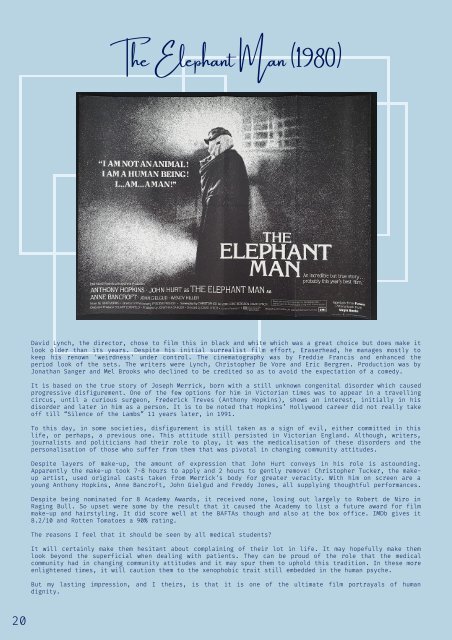PANACEA 2020
panacea /ˌpanəˈsiːə/ noun a solution or remedy for all difficulties or diseases. The term ‘Panacea’ embodies humanity’s unfaltering idealism, our wishful thinking and our unattainable dreams. It is this idealism which lays the foundation for our ambition and perseverance in the face of unparalleled hardship, and which fuels our resilience after defeat. In a time like the present and indeed throughout history, the concept of a ‘Panacea’ has been a frank deviation from reality – it is nothing more than a fantasy or escape. Nonetheless, for us, ‘Panacea’ is a delight, a source of hope and a symbol of our unending optimism. This year, the theme of AMSA’s student magazine, Panacea, is “When the dust settles: Reflection and renewal in a COVID-19 world.” We asked medical students from across Australia to submit written pieces or artwork relevant to the theme, for publication in a colourful and engaging digital magazine. Please enjoy the compilation of these wonderful works in Panacea 2020.
panacea
/ˌpanəˈsiːə/
noun
a solution or remedy for all difficulties or diseases.
The term ‘Panacea’ embodies humanity’s unfaltering idealism, our wishful thinking and our unattainable dreams. It is this idealism which lays the foundation for our ambition and perseverance in the face of unparalleled hardship, and which fuels our resilience after defeat. In a time like the present and indeed throughout history, the concept of a ‘Panacea’ has been a frank deviation from reality – it is nothing more than a fantasy or escape. Nonetheless, for us, ‘Panacea’ is a delight, a source of hope and a symbol of our unending optimism.
This year, the theme of AMSA’s student magazine, Panacea, is “When the dust settles: Reflection and renewal in a COVID-19 world.” We asked medical students from across Australia to submit written pieces or artwork relevant to the theme, for publication in a colourful and engaging digital magazine. Please enjoy the compilation of these wonderful works in Panacea 2020.
You also want an ePaper? Increase the reach of your titles
YUMPU automatically turns print PDFs into web optimized ePapers that Google loves.
The Elephant Man (1980)<br />
David Lynch, the director, chose to film this in black and white which was a great choice but does make it<br />
look older than its years. Despite his initial surrealist film effort, Eraserhead, he manages mostly to<br />
keep his renown 'weirdness' under control. The cinematography was by Freddie Francis and enhanced the<br />
period look of the sets. The writers were Lynch, Christopher De Vore and Eric Bergren. Production was by<br />
Jonathan Sanger and Mel Brooks who declined to be credited so as to avoid the expectation of a comedy.<br />
It is based on the true story of Joseph Merrick, born with a still unknown congenital disorder which caused<br />
progressive disfigurement. One of the few options for him in Victorian times was to appear in a travelling<br />
circus, until a curious surgeon, Frederick Treves (Anthony Hopkins), shows an interest, initially in his<br />
disorder and later in him as a person. It is to be noted that Hopkins’ Hollywood career did not really take<br />
off till “Silence of the Lambs” 11 years later, in 1991.<br />
To this day, in some societies, disfigurement is still taken as a sign of evil, either committed in this<br />
life, or perhaps, a previous one. This attitude still persisted in Victorian England. Although, writers,<br />
journalists and politicians had their role to play, it was the medicalisation of these disorders and the<br />
personalisation of those who suffer from them that was pivotal in changing community attitudes.<br />
Despite layers of make-up, the amount of expression that John Hurt conveys in his role is astounding.<br />
Apparently the make-up took 7-8 hours to apply and 2 hours to gently remove! Christopher Tucker, the makeup<br />
artist, used original casts taken from Merrick's body for greater veracity. With him on screen are a<br />
young Anthony Hopkins, Anne Bancroft, John Gielgud and Freddy Jones, all supplying thoughtful performances.<br />
Despite being nominated for 8 Academy Awards, it received none, losing out largely to Robert de Niro in<br />
Raging Bull. So upset were some by the result that it caused the Academy to list a future award for film<br />
make-up and hairstyling. It did score well at the BAFTAs though and also at the box office. IMDb gives it<br />
8.2/10 and Rotten Tomatoes a 90% rating.<br />
The reasons I feel that it should be seen by all medical students?<br />
It will certainly make them hesitant about complaining of their lot in life. It may hopefully make them<br />
look beyond the superficial when dealing with patients. They can be proud of the role that the medical<br />
community had in changing community attitudes and it may spur them to uphold this tradition. In these more<br />
enlightened times, it will caution them to the xenophobic trait still embedded in the human psyche.<br />
But my lasting impression, and I theirs, is that it is one of the ultimate film portrayals of human<br />
dignity.<br />
20

















